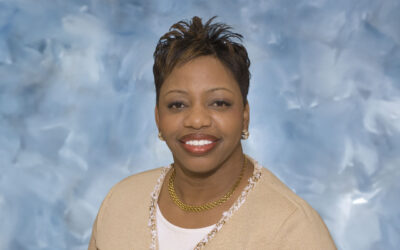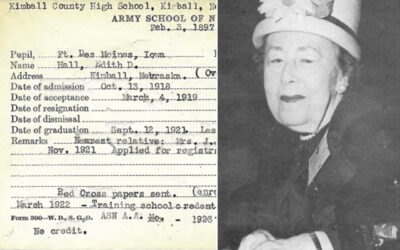
By Matt Skoufalos
When Brian Dawson was just 12 years old, his mother was diagnosed with breast cancer. He spent the next four-and-a-half years of his adolescence witnessing her undergoing surgery, chemotherapy, cancer treatment and, unfortunately, dying. Through it all, what he most remembered was how well the nurses tended to her as she fought for her life, and that experience cemented in his mind the decision to seek a career in medicine.
In between his junior and senior years at American University, Dawson participated in an immersive student nurse program through which he was detailed to the burn unit at Children’s National Medical Center in Washington, D.C. The physicians spent a handful of minutes with the patients and their families, and the rest of the time, nurses managed their pain.
“I’ve said it a number of times throughout my career: physicians cure and nurses care,” Dawson said. “I was the one who tucked them in, who would dress their burns, who held them, who took care of them and, to me, that was what I was there to do.”
 After graduating nursing school, Dawson was commissioned as an Ensign in the U.S. Navy, and was assigned to his first duty station in Oakland, California. While working the med/surg floor, Dawson met Patty Smith, an OR nurse who arrived every day to handle patients’ preoperative needs. Dawson took an interest in her work, and asked her how he could become an OR nurse; Smith became a lifelong mentor and his “Navy mom.”
After graduating nursing school, Dawson was commissioned as an Ensign in the U.S. Navy, and was assigned to his first duty station in Oakland, California. While working the med/surg floor, Dawson met Patty Smith, an OR nurse who arrived every day to handle patients’ preoperative needs. Dawson took an interest in her work, and asked her how he could become an OR nurse; Smith became a lifelong mentor and his “Navy mom.”
“I got into OR school and man, I found my world,” he remembered. Nothing felt more inspiring than the adrenaline rush that followed a surgical procedure that went smoothly, or the feeling of a surgeon saying “good job” at the end of the case. A two-sport athlete in high school, Dawson brought a level of competitiveness to the work he did in the OR, priding himself on facilitating cases and his team in order to have the fastest room turnover possible.
“It was a small unit, so it was me and two techs against the challenge,” he said. “I got to care for patients and I loved it. I used to go into surgery like the [1987 Florida State] Seminoles or the [University of Miami] Hurricanes. My team and I were the baddest OR nurses ever; my team and I had swagger.”
From there, his career took off. Dawson went from being a room nurse to having his own line of service to heading up a department at a two-room OR in North Carolina as a young Navy Lieutenant. He got to help design an OR at the naval hospital in Portsmouth, Virginia. As he progressed, so did Smith, his mentor; when she encouraged him to earn his master’s degree in nursing administration, Dawson enrolled in a fast-track program at Old Dominion University. There, he learned the business of health care as much as the science of it.
“That opened my eyes,” Dawson said. “How does that business run? COVID really illustrated how, when we shut down elective surgery, the money generated by health systems evaporated. I realized during graduate school that the OR was the engine, so now I had even more swagger: ORs are the engine that drive our hospitals, and I was given the pleasure of running that engine.”
After graduate school, Dawson went on to teach at the OR technician school at the Bethesda Naval Hospital, now known as Walter Reed National Military Medical Center. The opportunity brought him closer in spirit to his mother, who was a teacher. Dawson poured his energy and enthusiasm for his trade into the classroom. After an assignment that sent him to Okinawa, Japan, he returned to Bethesda to take over the OR there. Leveraging his education in the business of health care, Dawson made changes that began to generate revenue for the facility, which soon drew the notice of leadership.
First, Admiral Don Arthur, who eventually became the Navy Surgeon General, made Dawson the Homeland Security Officer for the national capital area during Gulf War II. Overseeing the Wounded Warrior Program, Dawson backfilled the hospital with reservists to keep its surgical unit operational. When Admiral Adam Robinson replaced Arthur, Dawson was his room nurse at Portsmouth Naval Hospital.
Robinson put him in charge of the “flag unit,” the executive medicine clinic, where he met high-ranking figures like U.S. Senator John Kerry and Chief Justice William Rehnquist. Dawson eventually became COO of the Naval Hospital at Marine Corps Base Camp Lejeune in Jacksonville, North Carolina, and was then later chosen to lead U.S. Naval Hospital Okinawa, in Japan as its CEO.
In his final two years in the Navy, Dawson was Robinson’s executive assistant and chief of staff at Navy Medicine during Robinson’s term as surgeon general. When he retired after 28 years, Dawson had risen to the rank of captain, and tucked away a lifetime of experiences.
“When I came in, there weren’t a lot of male nurses, or black nurses, and there weren’t a lot of black officers in Navy Medicine,” he said. “I had a lot of unbelievable mentors who saw something in me, and every door they opened, I ran through – and after I got through the door, I kept my foot in the door to help others come in. I’m still building teams, grooming young leaders to replace me.”
After retiring, Dawson “started to move backwards,” retracing his steps with his daughters in an effort to regain time that he’d dedicated to his professional career.
“I was just like my father,” he said. “I realized that I was the type of leader that really went out of my way for my staff, but I wasn’t necessarily doing that at home. I came to Colorado to be with my youngest, who was living here with her mom, my ex-wife. Working on my relationship with my youngest and her older sisters was when I made the transition from a father to a dad.”
“At the end of the day, no one’s going to say, ‘Brian Dawson was the first black, male nurse to command a naval hospital,’ ” he said. “What they’re going to talk about was how was I as a dad to those three girls, as a poppi to my grandchildren; and how was I as a true friend to the people that I know, and as a true partner to my significant other? That’s what they’re going to remember.”
Brian Dawson is currently the system vice president of Perioperative Services for CommonSpirit Health of Chicago, Illinois.









